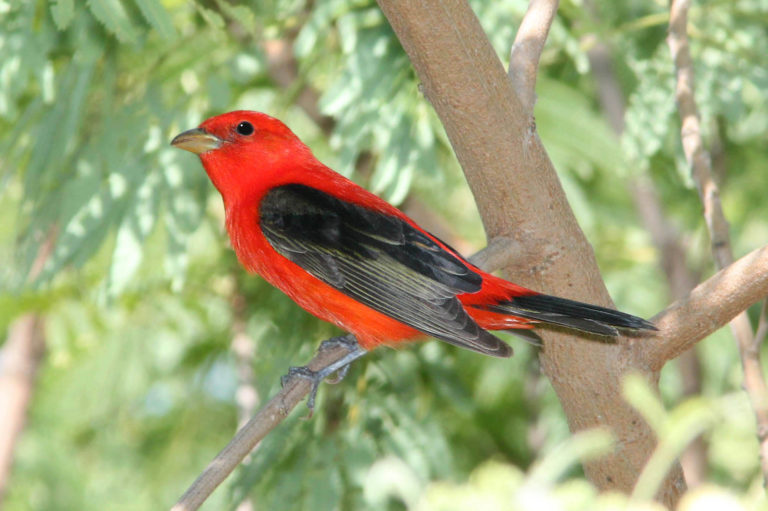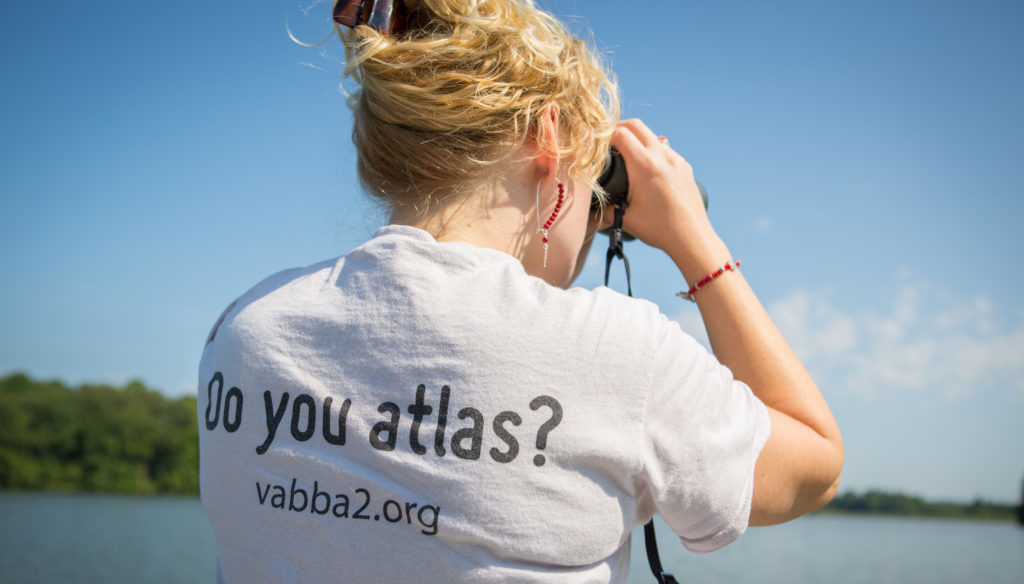By Jessica Ruthenberg, Watchable Wildlife Biologist, Virginia Department of Game and Inland Fisheries

Scarlet Tanager photo by Alan Schmierer.
As we take off into 2019, we reflect on 2018’s Year of the Bird, a celebration of birds that marked the centennial of the Migratory Bird Treaty Act (MBTA)—one of the first laws passed to protect wildlife and one of the most important for birds. Throughout 2018, the DGIF supported this national campaign, along with over 180 other organizations and agencies that work to protect birds and their habitats. We highlighted a sampling of our bird conservation work in Virginia; we shared the Commonwealth’s best birding opportunities and tips for getting started; and we offered numerous simple, but meaningful actions that we all can take to help birds.
Not only are birds beautiful and fascinating to observe, but they are beneficial to humans and we are very fortunate to have them living around us. Birds consume countless quantities of pests, including insects and rodents; they disperse seeds efficiently, helping our forests and grasslands to flourish; and they indicate the health of our water, air, and natural areas. In this final Year of the Bird article, we have summarized all of the simple, meaningful actions you can take to help Virginia’s birds thrive in 2019 and beyond. As one first step to take this year, please share this article with others to show your appreciation for birds and the easy ways that we can all give back to our feathered friends.
How to Help Birds
Enhance and Protect Bird Habitat

Pollinator Habitat Demonstration Garden at Pleasant Grove Park, Fluvanna County, established by the Virginia Department of Game and Inland Fisheries Habitat Partners© Program, in cooperation with Powhatan-Goochland Master Gardeners. This native plant garden received a Virginia Association of Counties Achievement Award in 2015.
- Grow Native Plants.Native plants will attract and support birds around your home by providing them with food, protective cover, and nesting locations. The DGIF and Audubon provide helpful resources for selecting the best native plants for birds and the Virginia Native Plant Society has a helpful list of native plant nurseries.
- Contact DGIF’s Team of Private Lands Wildlife Biologists (PLWBs), if you are a Landowner. Jointly hired with Virginia’s Natural Resources Conservation Service, PLWBs specialize in on-site landowner habitat evaluations followed by detailed management planning. To find out if your area is eligible, contact your local PLWB or DGIF’s Small Game Project Leader, Marc Puckett at 434-392-8328, [email protected].
- Drink Shade-grown Coffee. Shade coffee plants in Latin America are grown under tall trees, which provides habitat for the Cerulean Warbler (and many other neotropical migrant bird species) on its wintering grounds. The alternative, ‘sun coffee’, is grown as a row crop and is contributing heavily to loss of bird habitat through deforestation.
- Reduce Your Use of Pesticides. Insects and their larvae are a vital food source for birds, particularly for feeding young and during their migrations. Some pesticides are harmful to birds. Try these alternatives and prevention tips.
- Do Less Yardwork in the Fall. Less is more–leave your leaves, skip garden clean up until spring, and do not mow old fields until mid-March. Fallen leaves, dry stalks, and seedheads provide a safe shelter for dormant insects and insect eggs, a critical food resource for most bird species, especially come springtime. Dry stalks and brush provide birds protective cover from predators and seedheads bear food that birds can eat all winter long.

Juvenile tricolored heron at Hog Island WMA. Photo by Dan Whiting.
Keep Birds Safe
- Keep Pet Cats Indoors.According to the 2014 State of the Birds report, free-ranging outdoor domestic cats in the U.S. collectively kill approximately 2.4 billion birds every year, making them the number-one direct, human caused threat to birds.
- Make your Windows Obvious. National Audubon Society estimates that between 100 million to 1 billion birds a year die from collisions with reflective or clear glass. Reduce the risk of collisions with windows by trying these bird-friendly window solutions.
- Turn Building “Lights Out” during Bird Migration (April/ May and September/ October). Many birds migrate at night, using the stars and moon to help them navigate. Light pollution from cities, particularly from skyscrapers, can attract or disorient birds, leading to their collisions with buildings or windows, or a bright beam can “trap” birds, who then exhaust themselves while they circle. For easy ways to help reduce light pollution from high-rises, see Audubon’s Lights Out program.
- Reduce Plastic and Do Not Litter. Properly dispose of trash (about 80% of ocean plastic comes from land-based litter); reduce your use of single-use plastics (eg. plastic shopping bags, bottled water, and plastic straws); and do not release balloons (remember -what goes up must come down). All of these actions will help coastal birds and other coastal wildlife.
- Practice Bird-safe Behavior at the Beach. Watch where you step (beach nesting birds lay their well-camouflaged eggs directly on the sand), do not feed the gulls (one becomes many and they will eat shorebird eggs and chicks), and keep your dogs leashed or at home (free-roaming dogs are a danger to shorebird eggs and chicks).
Start Birding and Share Your Love of Birds with Others
- Visit our new Birding Basics Webpage. Here you will find numerous tips to get started in the wonderful world of birding.
- Explore the Virginia Bird & Wildlife Trail (VBWT) with your family and friends. This trail system will guide you to the best places in the Commonwealth to see native birds and wildlife.
- Join a Bird club. Birding with others adds to the enjoyment and it is the best way to improve your skills. Find a local club at Audubon.org and Virginiabirds.org.
- Share Your Shot. Submit your bird photos to the annual Virginia Wildlife Photo Showcase. In honor of 2018’s Year of the Bird, the contest features a special sub-category for Virginia’s native birds, especially neotropical migrants. New to bird photography? Check out these bird photography tips.
- Take a Child to Nature – Introduce a child you know to nature or make a purchase from the DGIF e-store to support the Virginia Wildlife Grant Program, a funding source to connect youth to the outdoors. A single encounter with a bird or other wild animal can spark a life-long passion.

Conducting a VABBA2 Survey at Amelia WMA. Photo by Meghan Marchetti.
Give Back
- Participate in the Virginia Breeding Bird Atlas (VABBA2). This DGIF-sponsored citizen science project will support bird conservation in the Commonwealth by documenting the status and distribution of our breeding birds. Get started as a volunteer at VABBA2.org.
- Contribute to DGIF’s Non-Game Fund to support the conservation of Virginia’s Species of Greatest Conservation Need listed in Virginia’s Wildlife Action Plan, including Loggerhead Shrikes, Cerulean Warblers, Golden-winged Warblers, numerous shorebird species, and so much more. Make a donation online by registering at Go Outdoors Virginia.
- Purchase an Access Permit to support conservation on Virginia’s public lands. This permit also acts as your pass to visiting 42 Wildlife Management Areas and numerous DGIF-owned lakes. Available for purchase by registering at Go Outdoors Virginia or calling 1-866-721-6911.



